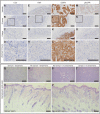A flexible electronic strain sensor for the real-time monitoring of tumor regression
- PMID: 36112679
- PMCID: PMC9481124
- DOI: 10.1126/sciadv.abn6550
A flexible electronic strain sensor for the real-time monitoring of tumor regression
Abstract
Assessing the efficacy of cancer therapeutics in mouse models is a critical step in treatment development. However, low-resolution measurement tools and small sample sizes make determining drug efficacy in vivo a difficult and time-intensive task. Here, we present a commercially scalable wearable electronic strain sensor that automates the in vivo testing of cancer therapeutics by continuously monitoring the micrometer-scale progression or regression of subcutaneously implanted tumors at the minute time scale. In two in vivo cancer mouse models, our sensor discerned differences in tumor volume dynamics between drug- and vehicle-treated tumors within 5 hours following therapy initiation. These short-term regression measurements were validated through histology, and caliper and bioluminescence measurements taken over weeklong treatment periods demonstrated the correlation with longer-term treatment response. We anticipate that real-time tumor regression datasets could help expedite and automate the process of screening cancer therapies in vivo.
Figures




References
-
- Drost J., Clevers H., Organoids in cancer research. Nat. Rev. Cancer 18, 407–418 (2018). - PubMed
-
- Vlachogiannis G., Hedayat S., Vatsiou A., Jamin Y., Fernández-Mateos J., Khan K., Lampis A., Eason K., Huntingford I., Burke R., Rata M., Koh D.-M., Tunariu N., Collins D., Hulkki-Wilson S., Ragulan C., Spiteri I., Moorcraft S. Y., Chau I., Rao S., Watkins D., Fotiadis N., Bali M., Darvish-Damavandi M., Lote H., Eltahir Z., Smyth E. C., Begum R., Clarke P. A., Hahne J. C., Dowsett M., de Bono J., Workman P., Sadanandam A., Fassan M., Sansom O. J., Eccles S., Starling N., Braconi C., Sottoriva A., Robinson S. P., Cunningham D., Valeri N., Patient-derived organoids model treatment response of metastatic gastrointestinal cancers. Science 359, 920–926 (2018). - PMC - PubMed
-
- Clarke M. A., Fisher J., Executable cancer models: Successes and challenges. Nat. Rev. Cancer 20, 343–354 (2020). - PubMed
-
- Gao H., Korn J. M., Ferretti S., Monahan J. E., Wang Y., Singh M., Zhang C., Schnell C., Yang G., Zhang Y., Balbin O. A., Barbe S., Cai H., Casey F., Chatterjee S., Chiang D. Y., Chuai S., Cogan S. M., Collins S. D., Dammassa E., Ebel N., Embry M., Green J., Kauffmann A., Kowal C., Leary R. J., Lehar J., Liang Y., Loo A., Lorenzana E., McDonald E. R., McLaughlin M. E., Merkin J., Meyer R., Naylor T. L., Patawaran M., Reddy A., Röelli C., Ruddy D. A., Salangsang F., Santacroce F., Singh A. P., Tang Y., Tinetto W., Tobler S., Velazquez R., Venkatesan K., Von Arx F., Wang H. Q., Wang Z., Wiesmann M., Wyss D., Xu F., Bitter H., Atadja P., Lees E., Hofmann F., Li E., Keen N., Cozens R., Jensen M. R., Pryer N. K., Williams J. A., Sellers W. R., High-throughput screening using patient-derived tumor xenografts to predict clinical trial drug response. Nat. Med. 21, 1318–1325 (2015). - PubMed
MeSH terms
Grants and funding
LinkOut - more resources
Full Text Sources
Other Literature Sources

